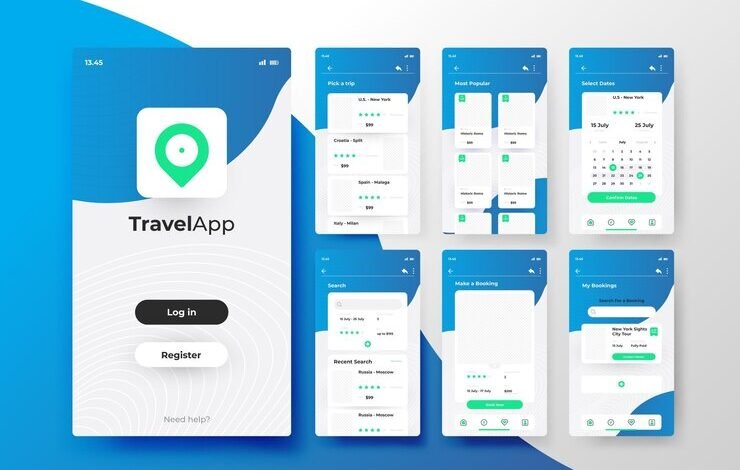
Developing a bus ticket booking app can open doors to a lucrative market, providing convenience for travelers while allowing bus operators to streamline their operations. However, creating a successful app requires more than just coding skills; it requires attention to detail, strategic planning, and avoiding some common pitfalls that can lead to failure. In this article, we’ll explore the most common mistakes developers and businesses make when building a bus ticket booking app, and how to avoid them for a smooth and efficient app development process.
1. Ignoring User Experience (UX) Design
A common mistake in bus ticket booking app development is ignoring the user experience (UX) design. Many developers focus heavily on the technical aspects, forgetting that the app must be easy to use. Poor navigation, cluttered interfaces, and confusing menus can frustrate users, leading them to abandon the app altogether.
How to Avoid This Mistake:
Invest in UX/UI design from the beginning. Conduct user research to understand your target audience’s needs and preferences. The app should feature a clean, intuitive interface with easy-to-use navigation. Elements like simple booking processes, clear payment options, and visible seat availability are crucial for creating a seamless user experience. Also, don’t forget to test the app frequently with real users to gather feedback and make necessary improvements.
2. Neglecting Mobile Optimization
Another common mistake is developing an app that isn’t fully optimized for mobile devices. Users expect smooth performance, fast loading times, and mobile-friendly interfaces. If the app doesn’t perform well on smartphones or tablets, users may abandon it, costing you potential revenue and engagement.
How to Avoid This Mistake:
Ensure that your app is optimized for mobile performance from the start. Use responsive design principles to ensure the app works well on various screen sizes. Additionally, prioritize speed and ensure that your app loads quickly, as users are unlikely to wait more than a few seconds for it to respond.
3. Failing to Provide Offline Features
Bus ticket booking apps are often used by travelers who might be in areas with poor or no internet connection, especially when traveling in rural areas. Failing to offer offline capabilities can hinder users from accessing important information, such as their ticket details or trip schedules, when they need it the most.
How to Avoid This Mistake:
Incorporate offline functionality into the app by allowing users to access their bookings, tickets, and travel information without an internet connection. You can also allow users to browse schedules and check seat availability offline, with updates syncing automatically when they reconnect to the internet.
4. Overlooking Security and Data Protection
Data security is a crucial concern for any app that handles personal information, and bus ticket booking apps are no exception. A common mistake is not implementing strong security protocols, leading to potential breaches where users’ sensitive data, such as credit card information, can be compromised.
How to Avoid This Mistake:
Prioritize security by incorporating end-to-end encryption for all user transactions and data storage. Ensure compliance with relevant data protection laws, such as GDPR or CCPA. Regularly conduct security audits and implement multi-factor authentication (MFA) for added layers of protection. Educating users on how to keep their information secure can also enhance trust in your app.
5. Lack of Integration with Multiple Payment Gateways
One of the primary functions of a bus ticket booking app is facilitating secure and efficient payments. However, limiting the app to one or two payment gateways can alienate a significant portion of users who prefer other payment options. Lack of payment diversity may result in missed opportunities.
How to Avoid This Mistake:
Integrate multiple payment gateways into the app, supporting various payment methods such as credit cards, debit cards, mobile wallets, and even cryptocurrencies. Ensure that your payment gateway supports regional preferences as well, particularly if you are targeting a global audience.
6. Overcomplicating the Booking Process
Complex booking processes are one of the quickest ways to lose customers. Many apps make the mistake of requiring too much information or including unnecessary steps during the booking process, frustrating users and leading to high abandonment rates.
How to Avoid This Mistake:
Streamline the booking process by only asking for essential information. Implement features like guest checkout to allow users to book tickets without creating an account. Use autocomplete and data-saving features to speed up the process for returning users. Keep the number of steps as minimal as possible—from selecting a trip to final payment, simplicity is key.
7. Poor Customer Support Integration
Bus ticket booking apps often overlook the importance of providing robust customer support features. Without easy access to customer service, users can become frustrated if they encounter issues with their bookings or need assistance during their travel.
How to Avoid This Mistake:
Integrate various customer support options, such as live chat, email support, and phone support, directly into the app. Consider using AI-powered chatbots to handle common inquiries and offer real-time assistance. Also, ensure that there is a comprehensive FAQ section available within the app to help users resolve simple problems on their own.
8. Failure to Scale the App for Growth
Another frequent mistake is not planning for the future scalability of the app. Many developers build an app that works well for small-scale operations but fails when the user base grows, leading to slow performance, crashes, or even downtime during peak usage periods.
How to Avoid This Mistake:
Develop the app with scalability in mind. Use cloud infrastructure that can handle fluctuations in traffic and data volume, especially during busy travel seasons. Test the app’s performance under different levels of stress to identify bottlenecks and improve system architecture accordingly.
9. Not Considering Multilingual and Multi-currency Features
In today’s global market, apps that cater to users from different regions must account for language and currency differences. A common mistake is limiting the app to one language or currency, which restricts its reach and usability for international travelers.
How to Avoid This Mistake:
Include multilingual and multi-currency support, especially if you plan to serve users from multiple countries. Ensure that your app translates seamlessly between languages and converts currencies accurately during the booking and payment process. This will help improve the user experience and attract a broader audience.
10. Failing to Regularly Update and Maintain the App
Once the app is launched, many developers neglect regular updates and maintenance. As user preferences change and new technologies emerge, failure to keep your app up-to-date can lead to performance issues, security vulnerabilities, and a drop in user satisfaction.
How to Avoid This Mistake:
Establish a regular schedule for app updates and maintenance. Continuously monitor the app for bugs, glitches, and performance issues. Stay up-to-date with the latest technological advancements, such as new payment methods, security protocols, and UI/UX trends, and implement these features to ensure your app remains competitive.
Conclusion
Developing a successful bus ticket booking app requires technical skill, strategic planning, and user-centric design. By avoiding these common mistakes—such as neglecting UX, underestimating security, and failing to scale for growth—you can create a more efficient, secure, and user-friendly app that meets your customers’ needs and stands out in a competitive market. Regular updates, clear customer support, and proper optimization will ensure your app remains relevant and useful for travellers everywhere.
FAQs
1. What is the most important feature of a bus ticket booking app?
The most important feature is a seamless booking process, from selecting a seat to making payments. Ensuring the app is easy to navigate and offers clear, straightforward options will make the user experience pleasant.
2. How can I ensure my bus ticket booking app is secure?
Implementing strong encryption, multi-factor authentication, and regular security audits are key steps to securing your app. Additionally, complying with international data protection regulations ensures users’ sensitive information is well-protected.
3. Why is offline functionality necessary for a bus ticket booking app?
Offline functionality allows users to access their tickets and travel information even without an internet connection. This is particularly important for travellers who may find themselves in areas with poor network connectivity.
4. How can I avoid common performance issues in my bus ticket booking app?
To avoid performance issues, ensure the app is well-optimized for mobile devices, implement scalable cloud infrastructure, and regularly conduct stress tests to identify and fix potential bottlenecks.



